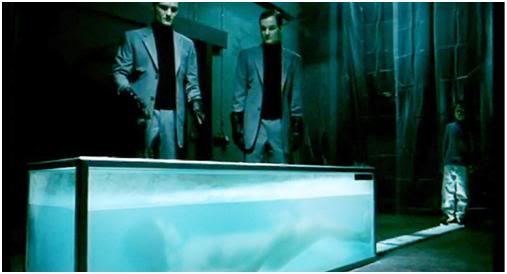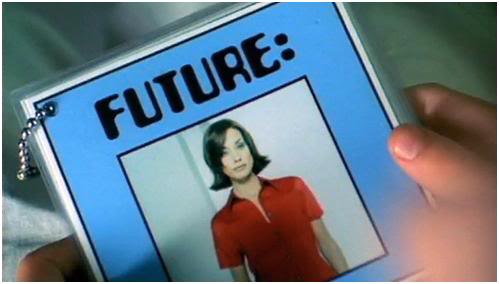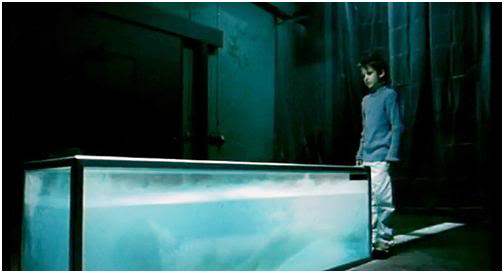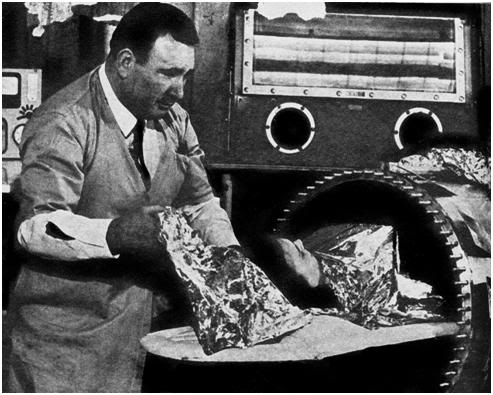
Monitoring the CryoCultural Penetration of the Groundwater
By Mike Darwin
We had arrived ahead of our host, and it was starting to rain. We were unprepared for the rain, and it wasn’t just a matter our getting a little damp; there was the laptop computer to consider, and all the other “personal electronic” devices, now essential to survival in the 21st century. Unfortunately, the two men dressed completely in black, guarding the entryway with automatic weapons, seemed disinclined to be moved by our plight. A few calls over the building’s intercom secured us entrance, and a short time later the Oligarch who we were there to meet arrived and escorted us into the office suite, to carry on the day’s discussions. The discussions were long and unproductive – at least from my point of view. My position was that cryonics required a dynamic and coherent philosophy, coupled to an organizational framework that would sustain it, through what I believed were very difficult times to come. The others were more interested in the brass tacks of business than the golden words of philosophy.
 I was getting nowhere, and, late in the day, my host for this visit, who was clearly fatigued from the days’ labors, brightened and said, “Come over here, I want to show this to you, this has been popular here.” I presume he accessed http://rutube.ru/tracks/1011220.html?v=5ebd95ec8a8706396bd3cc90d541c698 on his computer, and within a few seconds, “Mom in Love and Daddy in Space” by the Danish rock group Kashmir[1] took shape on the small screen of the laptop. The Russian link was to a blurry video, but it didn’t matter much. The images were haunting, and strangely cryonically archaic. The music began with visuals of the interior of a massive, futuristic home where a woman sits working at a table, while a man plays an unrecognizable game with a young boy, using a silvery metal board with scooped out divots, holding countless silver metal beads the size of BBs. (A high quality video of the song is available at: http://www.youtube.com/watch?v=11kep5f0cgo )
I was getting nowhere, and, late in the day, my host for this visit, who was clearly fatigued from the days’ labors, brightened and said, “Come over here, I want to show this to you, this has been popular here.” I presume he accessed http://rutube.ru/tracks/1011220.html?v=5ebd95ec8a8706396bd3cc90d541c698 on his computer, and within a few seconds, “Mom in Love and Daddy in Space” by the Danish rock group Kashmir[1] took shape on the small screen of the laptop. The Russian link was to a blurry video, but it didn’t matter much. The images were haunting, and strangely cryonically archaic. The music began with visuals of the interior of a massive, futuristic home where a woman sits working at a table, while a man plays an unrecognizable game with a young boy, using a silvery metal board with scooped out divots, holding countless silver metal beads the size of BBs. (A high quality video of the song is available at: http://www.youtube.com/watch?v=11kep5f0cgo )
The video cuts to a man in nondescript, but vaguely futuristic business attire, who mounts a staircase embedded in walls made from raw concrete, left with exposed joints and formwork in its surface, and the words begin:
Walking bones
Choose your own direction
Go have fun
Some place else
Bring your soul
And your Beach Boys records
I can’t stand
To have you here
The message is clear: death is not welcome here – go somewhere else, in this place we have no use for you, and will no longer tolerate your presence. It becomes apparent that the woman is in the process of creating a bio-duplicate of her husband – what will, in fact, be the third such duplicate. There are two Dads in this house and this world, but why, and at what cost? The lyrics continue, along with the haunting and melancholy music.
The lights flicker throughout the house, as if there has been a short in the circuitry, and the father rises from the game with the boy, leaves the boy behind, and meets with his duplicate outside the room he has just exited. They begin their descent in unison, side by side, down a curved staircase that seems to be be floating in the air:
So worn out
Cold and dehydrated
The fortune is spent
And dad is in space
The boy turns his attention to an aquarium in the room his Father has just departed.

Every home should have a mom in love
And a daddy in space
Chinese porcelain cats
To guard her love
In the window space
Show her some respect
She’s all worn down
The two Dads find the Mother collapsed on the floor. One reaches out and palpates her carotid pulse, only to find her lifeless.

For years to come
I will not forget you
As my son
As my pain
They consult a set of laminated pocket flip-cards entitled “Cryonic Suspension Manual”and abbreviated “CSM.”
 Meanwhile, the water in the aquarium filled with tropical fish that the boy has been watching nucleates, and almost instantaneously flashes over into ice.
Meanwhile, the water in the aquarium filled with tropical fish that the boy has been watching nucleates, and almost instantaneously flashes over into ice.
 The two Dads pick up the lifeless body of the Mother and place her on a stainless steel gurney. The lyrics continue:
The two Dads pick up the lifeless body of the Mother and place her on a stainless steel gurney. The lyrics continue:
Time will heal
What now feels so wounded
Tears are spilled
And the holes will fill
Every home should have a mom in love
And a daddy in space
Chinese porcelain cats
To guard her love
In the window space
Show her some respect
She’s all worn down
Show her some respect
She’s all worn down
Show her some respect
She’s all worn down
The images on the screen show the CSM being consulted, with the instructions to “lower body temperature.” Mom is seen surrounded by a cocoon of aluminized Mylar, with ice packed around her – two cubes rest in her sternal notch in a puddle of melted water.

Every home should have a mom in love
And a daddy in space
Chinese porcelain cats
To guard her love
In the window space
The music and the lyrics continue and repeat, and the boy is seen seated at a table that is covered in snow, as his Mom is wheeled out of the great room of the house on the gurney, shrouded in Mylar foil, with just her face exposed.

The boy is seen standing in a hallway as his two Dads wheel his mother into some (presumably?) subterranean space. His expression is one of concern, and perhaps shock.

While he stands in the background looking on, his two Dads place his Mother’s naked body into an aquarium-like cryogenic vat, where she sinks to the bottom of the vapor covered liquid.

The boy has earlier been given what appears to be one of the laminated cards from the CSM and, after the departure of his Dads, he pensively approaches the tank containing his Mother and lays the card gently, with poignant reverence and anticipation, atop the cryogenic vessel.

We are shown that the card is imprinted with a photo of his Mom with the word “FUTURE:”above it.

The last image in the video is that of the foot-end of the cryo-vessel, with the words FREEZE-WAIT-REANIMATE printed on it.

I found myself both deeply moved and deeply surprised. The video and the music perfectly captured the pain, longing, and hope that was and is cryonics. But the images, and the language, are cryo-relics. They come from the early days of cryonics in the 1960s, as does the “retro-futuristic” computer-font used on the CSM cards. Does CSM stand for the Cryonics Society of Michigan, I wondered to myself? Freeze-Wait-Reanimate has not been in use in cryonics since the mid-1960s, when the word “cryonics” was coined, and displaced it from the lexicon as a descriptor of the discipline of cryopreserving people. The same is true for the aluminized Mylar (or aluminum foil) in which early cryonics patients were wrapped.

E. Francis Hope, photographed with a model posing wrapped in Mylar foil for a publicity photo, made circa 1967 at Cryo-Care Equipment Corporation in Phoenix, AZ.
I was struck by two conflicting interpretations of what I’d just seen. Was the vision in this video a delayed playback of images inserted into the culture nearly 50 years ago, or was it instead, a retrofuturistic or a paleofuturistic (http://www.paleofuture.com/) view of cryonics? It was impossible to tell.
A few months ago, in the muffled distance, I heard the haunting score of the same Kashmir video, quite unexpectedly, in one of the dark warrens that comprise the city of Los Angles’ underbelly. At first, I mistook it for the opening chords of the Eagles’ “Hotel California,” but as I walked towards the source of the sound, I realized it was “Mom in Love…” It was a recording of a live performance by Kashmir, made somewhere in Europe a few years ago, from the look of it. It was streaming from the Internet through the tinny speakers of a careworn laptop. I stood next to the man who owned the computer, exchanged a glance of permission, and listened until the music stopped, and the moving image froze.
Whatever its origin, the source code had come through loud and clear. The song was full of loss, and hope, and longing, and as I looked into the face of the laptop’s owner, I could see he had heard the message, too.
Sadly, I guess that’s really all we can ask for, or at least all we can expect to get, 50 years after cryonics was first loosed on the world.
[1] Kashmir is a Danish rock band formed in 1991 by Kasper Eistrup (vocals and lead guitar) with Mads Tunebjerg (bass); Asger Techau (drums) and Henrik Lindstrand (keyboards and guitar). In November 2009, Kashmir released their first single “Mouthful of Wasps” on the band’s website. Trespassers, the band’s sixth full-length album, was released in February of last year.

“Sadly, I guess that’s really all we can ask for, or at least all we can expect to get, 50 years after cryonics was first loosed on the world.”
Yeah, I guess that is all you can get for cryonics, considering this nerd-centric version of cryonics, which is the only version we have ever had.
The game, incidentally, looks like Mancala (http://en.wikipedia.org/wiki/Mancala).
Thanks! I had no idea! — Mike Darwin
An incremental development in nanotechnology for you:
http://nextbigfuture.com/2011/03/molecular-motor-design-breakthrough.html
If you download and read the 72 page technical description, you will note this is all “wet” nanotechnology. These kind of developments appear quite common these days. This field is a lot like semiconductors, say, in the 1960′s.